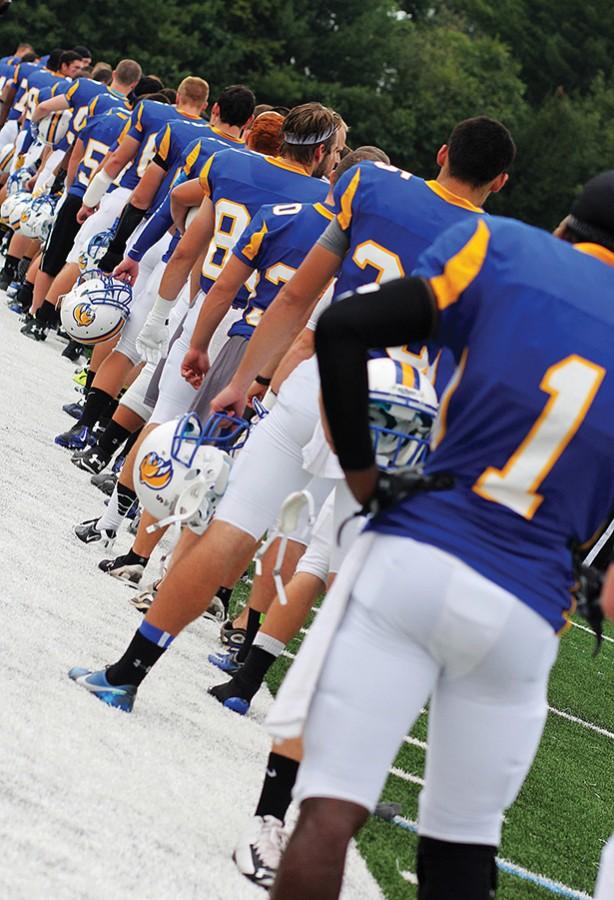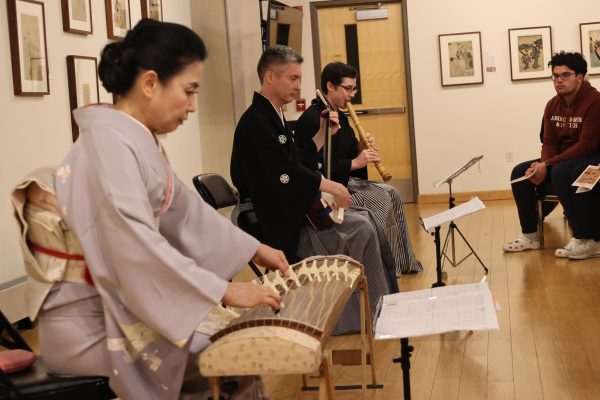Are Male Student Athletes Winning in Class?
December 16, 2015
When Bill Birmingham, a sophomore accounting major, decided to walk on to the men’s soccer team last fall, he wasn’t fully prepared for the expectations that were to come. His previous schedule, which involved getting back from class to nap, catch up on his Netflix show, and play video games—homework thrown in between and after—turned into leaving his 3:30 Intermediary Accounting class and immediately heading to a 4:30 p.m. practice for which he was already 15 minutes late.
His toes tapped uncontrollably as he checked the time on his phone and watched each minute go by. Some days, his professor let out class a few minutes early so he didn’t miss the early stages of practice, but not this day. The clock struck 4:30, his professor dismissed class, and he was quick to leave, running to McGeehan turf field on the other side of campus while clutching three bags. When practice ended around 6:30, he and the team hurried over to the dining hall to grab dinner before caf staff removed the hot meals from the counter. After dinner, he went back to the field house to drop off his equipment and shower. By the time he got back to his room, it was well past 8:00 p.m. and he had yet to open his books to do hours worth of homework.
Although practice times varied each week, the routine, for the most part, stayed the same. A month or so into the season, Bill was feeling the mental and physical drain of intercollegiate sports, but what surprised him the most was that his GPA in the 2015 fall semester was better than his cumulative GPA the previous year. His grades got better.
Birmingham’s academic achievement is uncommon. If there were an academic battle of the sexes, the women seem to be winning. According to the Office of Institutional Research, the female student-athlete GPA was higher than that of male student-athletes in spring 2015. Women earned a 3.43, while the overall GPA of males was 2.91.
While the difference is relatively small, it is worth considering. According to the book, “Women: The Growing Gender Gap in Education and What it Means for American Schools” by Ohio State University sociology professors Claudia Buchmann and Thomas DiPrete, it’s not only male athletes who are falling behind, but all men. Buchmann argued that one reason may be outdated views of masculinity that don’t place much value in academic success.
In 2011, the NCAA surveyed student-athletes to see how they identify themselves. Male athletes, especially football and basketball players, identified more as athletes rather than students and gave more weight choosing a college based on its athletics rather than its academics.
The notion that sports trumps academics among male student athletes is not new.
Cardale Jones, sophomore quarterback for The Ohio State University, exemplified this when he tweeted: “Why should we have to go to class if we came here to play FOOTBALL. We ain’t come to play SCHOOL classes are pointless.”
Granted, Division III athletics is an entirely different ball game—no pun intended. At the Division I level, many athletes play with the aspirations and expectations of turning professional after graduation. The Division III level, however, is for athletes who don’t expect to go pro. DIII players primarily focus on earning degrees while playing sports at a level that doesn’t require the commitment of a Division I athlete.
In 2008, the Journal of Intercollegiate Sports and the NCAA conducted a study to compare the academic performance of student athletes during and out of season. Researchers examined over 3,000 Division III student-athletes from eight schools and found that student-athletes have slightly lower GPAs per semester in-season than they did out-of-season.
“The average in-season GPA was 2.93 and the average out-of season GPA was 3.00. Within sport, student-athletes in men’s lacrosse and women’s volleyball exhibited the greatest average drop-off in GPA,” wrote researchers Brianna Scott, Thomas Paskus, and Todd Petr. Additionally, The College Sports Project, a group that represents over 80 universities at the Division III level, analyzed data and found that recruited Division III athletes don’t do as well in the classroom as non-athletes do. Male non-athletes ranked in the 47th percentile of GPA and women placed in the 55th. Recruited male and female athletes ranked 37th and 51st respectively.
At Misericordia, however, student-athletes out-perform their peers. Chuck Edkins, the newly appointed Athletic Director, said student-athletes have always maintained a combined GPA at the end of each semester as well as academic year greater than, or equal to, the non-athlete student population. The overall student-athlete GPA has never been below a 3.0. Edkins said 508 student athletes had an overall 3.27 GPA in spring 2015.
“Our student athletes are not only having success on the field, court, or in the pool,” he said. “They’re having great success in the classroom.”
“One of the pieces of mail that I got in this office was a notification regarding men’s and women’s swim teams receiving some academic honors, and that’s really heartening to see. I’ve come from institutions where they play at the Division I level, and its really different in the sense of the experiences of the student athlete so far here at Misericordia,” said Dr. Charles Brody, Vice President of Academic Affairs.
Compared to the full-time, non-athlete, undergraduate population on campus, which is close to 2000 students, the average GPA in the spring of 2015 was a 3.24, according to Sharon Hudak, Director of Institutional Research. While it is important to note that the GPA of all 3000 plus students was 3.28, those numbers don’t fairly compare with student-athletes’ scores because they include part-time students who carry fewer credits per semester.
While Misericordia student-athletes as a whole have the same, if not higher academic achievement rates than their peers, the question remains: How do they do it?
Birmingham, who reported that his GPA is higher than the average for male athletes at Misericordia, said time management is the biggest factor in his academic turnaround.
“Last year, I had all the free time in the world to do my work, that I kept pushing it back until it almost became too late. With the incorporation of soccer into my routine, my schedule becomes limited and I only have a few hours of my day to devote to homework, so I really have to use them.”
Edkins said a majority of the student-athlete success falls on the coaches of each sport. Since the NCAA doesn’t mandate study halls, it gives schools autonomy as to how it helps students to progress academically towards degrees.
Each coach uses his or her own method of academic support.
Men’s soccer under Edkins, for example, requires three different study halls throughout the week: a weekly study hall for first year students, a weekly study for all players, and an individual study for
first years as well as any player who feels he needs it.
Edkins once worked as a liaison between academics and athletics as part of his position as Associate Athletic Director. That position now belongs to Robyn Stahovic, head coach of the field hockey team.
“The athletic department at Misericordia has worked extensively to ensure the academic success of its student-athletes. We have direct contact with the registrar’s office, faculty, and the Student Success Center. We are involved in every way possible, in the assistance of academic programs for our student-athletes,” said Edkins.
Edkins credits the “Agility, Intelligence, Motivation” program as well as the “Target” program for helping first year athletes juggle their sport with academic responsibilities. A.I.M. is a voluntary support program for students who are struggling in the classroom. The program consists of a five-week workshop series that assists students in skills they need in college. The “Target” program, however, is a required intervention program for the student who is placed on academic probation. Staffers maintain close contact with faculty and coaches of the students involved.
The threat of academic probation is another factor to help keep athletes on their academic toes. Edkins said the athletic department holds a strict GPA minimum for its student-athletes. While Edkins declined to provide the specific GPA required, he said it could be higher than the GPA minimum for student-athletes at other schools.
“In athletics, we support these programs and we make sure that our first year student-athletes in all sports are required to be there even though one is a voluntary program,” said Edkins. “Both programs are open to all students, but you’ll really see a lot of our student athletes, especially first years, there to help guide them to academic success.”
The athletic department emphasizes the importance of academic success for the first-year student-athlete because statistically, first-year students as a whole don’t do as well in the classroom as upperclassmen do.
But when they succeed, their work pays off in more ways than the numbers on a college transcript might indicate. It seems as if athletes don’t have to look too hard into their skill sets to find jobs, as many business owners and employers are keen on hiring former collegiate and even high school athletes over those who didn’t participate in sports.
David Williams, a contributor for Forbes, said he looks to hire those who show the traits of a competitive athlete. These traits include drive/relentlessness and the ability to achieve goals, develop new skills, and work well with others.
“Athletes are tenacious – they seldom or never give up,” he said. “If one avenue is blocked, they find another path to success. Athletes know how to leverage the unique and complementary strengths of each member of their team.”
Graduates who played sports may also earn more than non-athletes once they get jobs. In 2006, Dr. Daniel Henderson from the State University of New York at Binghamton coauthored a study that showed evidence to support that, in some cases, former collegiate athletes earn more than their peers who did play. The study found that a higher percentage of former athletes were in higher income brackets than non-athletes. Former athletes working in the military, manual labor and business fields also earned higher salaries than non-athletes. It also showed that a higher percentage of athletes furthered their education within six years of completing a bachelor’s degree. The study did however show that athletes were more likely to end up teaching in high school, where they made 8% less than non-athletes.
As for Bill, he’s got two more years before he earns his Bachelors degree and searches for his potential career path. For now, he plans on taking things one day at a time.
“I’m not going to lie. I’m pretty concerned for my grades now that the season is over,” he joked as he sat with his friends playing PlayStation. “There’s way too much time in my schedule now to play Madden and FIFA.”


